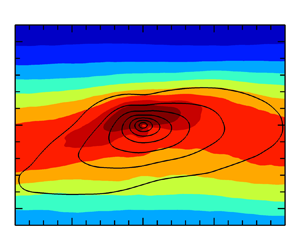No CrossRef data available.
Published online by Cambridge University Press: 16 January 2025

Direct numerical simulations of temporally developing compressible mixing layers have been performed to investigate the effects of large-scale structures (LSSs) on turbulent kinetic energy (TKE) budgets at convective Mach numbers ranging from  $M_c=0.2$ to
$M_c=0.2$ to  $1.8$ and at Taylor Reynolds numbers up to 290. In the core region of mixing layers, the volume fraction of low-speed LSSs decreases linearly with respect to the vertical distance at a Mach-number-independent rate. The contributions of low-speed LSSs to TKE, and its budget, including production, dissipation, pressure-strain and spatial diffusion terms, are primarily concentrated in the upper region of mixing layer. The streamwise and vertical mass flux coupling terms mainly transport TKE downwards in low-speed LSSs, and their magnitudes are comparable to the other dominant terms. Near the edges of LSSs, the sources and losses of all three components of TKE are completely different to each other, and dominated by turbulent diffusion, pressure diffusion, pressure-strain and dissipation terms. The TKE, their total variation and dissipation are significantly amplified at edges of low-speed LSSs, especially at the upper edge. This observation supports the existence of amplitude modulation exerted by the LSSs onto the near-edge small-scale structures in mixing layers. The level of amplitude modulation is strongest for the vertical velocity, followed by the streamwise velocity, and weakest for the spanwise velocity. Additionally, the amplitude modulation effect decreases significantly with increasing convective Mach number. The results on the amplitude modulation effect is helpful for developing predictive models of budget terms of TKE in mixing layers.
$1.8$ and at Taylor Reynolds numbers up to 290. In the core region of mixing layers, the volume fraction of low-speed LSSs decreases linearly with respect to the vertical distance at a Mach-number-independent rate. The contributions of low-speed LSSs to TKE, and its budget, including production, dissipation, pressure-strain and spatial diffusion terms, are primarily concentrated in the upper region of mixing layer. The streamwise and vertical mass flux coupling terms mainly transport TKE downwards in low-speed LSSs, and their magnitudes are comparable to the other dominant terms. Near the edges of LSSs, the sources and losses of all three components of TKE are completely different to each other, and dominated by turbulent diffusion, pressure diffusion, pressure-strain and dissipation terms. The TKE, their total variation and dissipation are significantly amplified at edges of low-speed LSSs, especially at the upper edge. This observation supports the existence of amplitude modulation exerted by the LSSs onto the near-edge small-scale structures in mixing layers. The level of amplitude modulation is strongest for the vertical velocity, followed by the streamwise velocity, and weakest for the spanwise velocity. Additionally, the amplitude modulation effect decreases significantly with increasing convective Mach number. The results on the amplitude modulation effect is helpful for developing predictive models of budget terms of TKE in mixing layers.